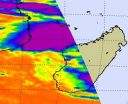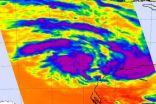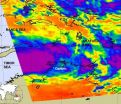(Press-News.org) Abnormal heart rate turbulence is associated with an increased risk of heart disease death in otherwise low-risk older individuals, according to a study funded by the National Heart, Lung, and Blood Institute (NHLBI), part of the National Institutes of Health.
This study appears in the Feb. 15 edition of the Journal of Cardiovascular Electrophysiology.
Among the nearly 1,300 study participants, heart rate turbulence, which reflects how well the heart reacts to occasional premature contractions, was an even stronger heart disease risk factor than elevated levels of C-reactive protein. CRP is a potential heart disease biomarker that has emerged in recent years.
Study participants considered at low risk of heart disease based on traditional risk factors were on average 8 to 9 times more likely to die of heart disease during the roughly 14-year follow-up period if they had abnormal heart rate turbulence values. Traditional risk factors include age, gender, high blood cholesterol, high blood pressure, obesity, diabetes, and smoking. Low-risk individuals with elevated CRP in their blood were about 2.5 times more likely to die than those with normal or low CRP.
"These findings suggest that apparently healthy people might be at increased risk of death from cardiovascular disease, and heart rate turbulence may help us identify them," said Susan B. Shurin, M.D., acting director of the NHLBI. "It will be important to see if we can replicate this finding in other populations."
This study followed 1,272 adults aged 65 and older as part of the NHLBI's Cardiovascular Health Study. Participants were categorized as healthy (no sign of heart disease risk except possibly diabetes), subclinical (some signs of heart disease) or clinical (had a cardiovascular event, such as a heart attack). At the onset, participants underwent 24-hour monitoring of their hearts' electrical activity through a small electrocardiographic, or ECG, device called a Holter monitor attached to their skin.
Abnormal heart rate turbulence and CRP levels both appeared to independently correlate with an increased likelihood of dying of heart disease in the group that was categorized as healthy, even after controlling for other risk factors. Abnormal heart rate turbulence–present in about 7 percent of the study participants–also predicted an increased likelihood of heart disease death in the subclinical and clinical groups, though these results were not as pronounced.
Heart rate turbulence refers to how smoothly the heart rate returns to normal after a premature ventricular contraction, a fairly common event in which the second portion of a heart beat is triggered too soon. Due to the improper timing between the atrial and ventricular contractions, the ventricles haven't fully filled with blood and therefore do not push out enough blood to the body. The brain detects this sub-optimal release of blood and instantly increases the heart rate to pump more blood. However, this overcompensation raises blood pressure, causing the brain to react again and lower the heart rate until blood pressure returns to normal.
By analyzing the heart's electrical signals, physicians can measure the magnitude of the initial heart rate jump (turbulence onset) and the speed at which heart rate returns to normal (turbulence slope), and then determine if the heart rate turbulence response is normal or abnormal.
"A heart rate turbulence measurement is insightful because it offers a sign of how well the autonomic, or subconscious, nervous system is functioning," said study author Phyllis K. Stein, Ph.D., a research associate professor of medicine and director of the Heart Rate Variability Laboratory at Washington University School of Medicine in St. Louis. "If someone's heart doesn't react well to these uncoordinated beats that might mean it's not good at reacting to other issues like sudden stress or severe arrhythmias."
Researchers don't yet know if abnormal heart rate turbulence can be treated or prevented. In the meantime, said Stein, interest might grow within the medical community in measuring heart rate turbulence in clinical practice. Currently, this type of measurement is not widely available.
"This study shows a great potential value for heart rate turbulence in diagnostic settings," said Robin Boineau, M.D., a medical officer in the NHLBI's Division of Cardiovascular Sciences. "It appears that signs of heart rate turbulence are also generally present a year or more before clinical manifestations of heart disease, indicating that this may be an opportunity for disease prevention in addition to disease prediction."
###
In addition to the NHLBI, the National Institute of Neurological Disorders and Stroke also contributed funding to this study.
To schedule an interview with an NHLBI spokesperson, contact the NHLBI Communications Office at 301-496-4236 or nhlbi_news@nhlbi.nih.gov.
Resources:
Cardiovascular Health Study (CHS): https://biolincc.nhlbi.nih.gov/studies/chs/
What Are Heart Disease Risk Factors? http://www.nhlbi.nih.gov/health/dci/Diseases/hd/hd_whatare.html
Part of the National Institutes of Health, the National Heart, Lung, and Blood Institute (NHLBI) plans, conducts, and supports research related to the causes, prevention, diagnosis, and treatment of heart, blood vessel, lung, and blood diseases, and sleep disorders. The Institute also administers national health education campaigns on women and heart disease, healthy weight for children, and other topics. NHLBI press releases, information on NHLBI's role in the American Recovery and Reinvestment Act, and other materials are available online at www.nhlbi.nih.gov.
The mission of the National Institute of Neurological Disorders and Stroke (NINDS) is to reduce the burden of neurological disease - a burden borne by every age group, by every segment of society, by people all over the world. For more information about NINDS, visit www.ninds.nih.gov
The National Institutes of Health (NIH) — The Nation's Medical Research Agency — includes 27 Institutes and Centers and is a component of the U.S. Department of Health and Human Services. It is the primary federal agency for conducting and supporting basic, clinical and translational medical research, and it investigates the causes, treatments, and cures for both common and rare diseases. For more information about NIH and its programs, visit www.nih.gov.
NIH-funded study finds new possible risk factor of heart disease
2011-02-16
ELSE PRESS RELEASES FROM THIS DATE:
Designing new molecular tools to study the life and death of a cancer cell
2011-02-16
Basic and translational research on cancer, and development of new cancer therapeutics, has focused on different aspects of cancer cellular function. One area of focus is the life and death of a cancer cell. Apoptosis, also known as programmed cell death, is a fundamental process of cells including cancer cells. The signal transduction pathways of apoptosis involve many different proteins and their interactions with each other. Protein-protein interactions involved in these apoptotic signals, like those in many other biological processes, are often determined or influenced ...
Astronomers identify thick disc of older stars in nearby Andromeda galaxy
2011-02-16
An international team of astronomers has identified for the first time a thick stellar disc in the Andromeda galaxy, the nearest large spiral galaxy to our own Milky Way.
The discovery of the thick disc, a major result from a five-year investigation, will help astronomers better understand the processes involved in the formation and evolution of large spiral galaxies like ours, according to the team, which includes UCLA research astronomer Michael Rich and colleagues from Europe and Australia.
Using the Keck Telescope in Hawaii, the astronomers analyzed the velocities ...
Overabundance of protein expands breast cancer stem cells
2011-02-16
HOUSTON - An essential protein for normal stem cell renewal also promotes the growth of breast cancer stem cells when it's overproduced in those cells, researchers at The University of Texas MD Anderson Cancer Center report in the February edition of Cancer Cell.
In mouse and lab experiments, the team also discovered that two drugs block the cascade of molecular events that they describe in the paper, thwarting formation of breast tumor-initiating cells.
"Overexpression of the EZH2 protein has been linked to breast cancer progression, but the molecular details of that ...
New material provides 25 percent greater thermoelectric conversion efficiency
2011-02-16
AMES, Iowa – Automobiles, military vehicles, even large-scale power generating facilities may someday operate far more efficiently thanks to a new alloy developed at the U.S. Department of Energy's Ames Laboratory. A team of researchers at the Lab that is jointly funded by the DOE Office of Basic Energy Sciences, Division of Materials Sciences and Engineering and the Defense Advanced Research Projects Agency, achieved a 25 percent improvement in the ability of a key material to convert heat into electrical energy.
"What happened here has not happened anywhere else," ...
NASA Satellite sees most of Cyclone Bingiza's rainfall over Mozambique Channel
2011-02-16
Infrared data from NASA's AIRS instrument revealed that the low level center of Cyclone Bingiza was still over land in western Madagascar this morning, but the bulk of its rainfall was over the Mozambique Channel.
When NASA's Aqua satellite flew over Madagascar this morning, Feb. 15 at 11:11 UTC (6:11 a.m. EST), the Atmospheric Infrared Sounder (AIRS) instrument read the temperatures of the cold thunderstorm cloud tops in Cyclone Bingiza. Most of the strongest thunderstorms were north and west of the center of circulation already over the Mozambique Channel, while Bingiza's ...
NASA Satellite sees two 'tropical fists' threatening Australia
2011-02-16
Australia is getting hit with two "tropical fists" as NASA satellites watch two low pressure areas develop near the Northern Territory and Western Australia. System 99S is currently strengthening near Darwin, Australia and another low pressure area called System 97S is strengthening near Western Australia.
System 97S was located about 210 nautical miles north-northwest of Learmonth, Western Australia, at 1800 UTC (1 p.m. EST), Feb. 15. It was centered near 19.2 South and 112.1 East. That puts the center of System 97S well to the northwest of Exmouth. System 97S is forecast ...
NASA Satellite catches a tropical cyclone forming near Darwin, Australia
2011-02-16
NASA's Aqua satellite captured a low pressure area known as System 99S that appears to be strengthening very close to Darwin, Australia. Aqua satellite data indicated that the strongest thunderstorms were over the Timor Sea on Feb. 15.
System 99S is a threat to Australia's Northern Territory because on Feb. 15 it was centered only 20 miles (32 km) south of Darwin, Australia, near 12.7 degrees South latitude and 130.7 degrees East longitude. The Joint Typhoon Warning Center gives System 99S a good chance for development in the next 24 hours, and NASA satellite imagery ...
Whole genome sequencing used to help inform cancer therapy
2011-02-16
SCOTTSDALE, Ariz. — Feb. 16, 2011 — Whole genome sequencing — spelling out a person's entire DNA genetic code — has moved one step closer to being a medical option for direct patient care.
Physicians and researchers at Mayo Clinic in Arizona and the Translational Genomics Research Institute (TGen) successfully completed sequencing both a single patients normal and cancer cells – a tour de force of more than 6 billion DNA chemical bases.
While the whole genomes of several individuals or their cancers have been sequenced in recent years, this is believed to be among the ...
Health care spending: Study shows high imaging costs for defensive purposes
2011-02-16
Nearly 35 percent of all the imaging costs ordered for 2,068 orthopaedic patient encounters in Pennsylvania were ordered for defensive purposes, according to a new study presented today at the 2011 Annual Meeting of the American Academy of Orthopaedic Surgeons (AAOS).
For many years now, some physicians have ordered specific diagnostic procedures that are of little or no benefit to a patient, largely to protect themselves from a lawsuit. Until now, however, efforts to actually measure defensive medicine practices have been limited primarily to surveys sent to physicians. ...
How To Use "The Ex Back System" To Avoid The Valentine's Day Hangover Blues!
2011-02-16
There are three things women usually do when trying to get their ex boyfriend back, but those actions will only succeed in persuading them to run in the opposite direction. The comprehensive multimedia program by Brian Bold, "The Ex Back System," helps women avoid those pitfalls and points them in the right direction to avoiding the Valentine's Day Hangover Blues!
"Women make three mistakes when a relationship breaks up," said Bold. "They act desperate, they tell their ex that this time will be different, and they constantly try to contact their ex. Instead of bringing ...




